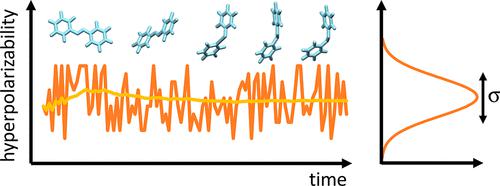当前位置:
X-MOL 学术
›
Acc. Chem. Res.
›
论文详情
Our official English website, www.x-mol.net, welcomes your feedback! (Note: you will need to create a separate account there.)
Predicting the Second-Order Nonlinear Optical Responses of Organic Materials: The Role of Dynamics
Accounts of Chemical Research ( IF 18.3 ) Pub Date : 2022-12-05 , DOI: 10.1021/acs.accounts.2c00616 Frédéric Castet 1 , Claire Tonnelé 2 , Luca Muccioli 3 , Benoît Champagne 4
Accounts of Chemical Research ( IF 18.3 ) Pub Date : 2022-12-05 , DOI: 10.1021/acs.accounts.2c00616 Frédéric Castet 1 , Claire Tonnelé 2 , Luca Muccioli 3 , Benoît Champagne 4
Affiliation

|
The last 30 years have witnessed an ever-growing application of computational chemistry for rationalizing the nonlinear optical (NLO) responses of organic chromophores. More specifically, quantum chemical calculations proved highly helpful in gaining fundamental insights into the factors governing the magnitude and character of molecular first hyperpolarizabilities (β), be they either intrinsic to the chromophore molecular structure and arising from symmetry, chemical substitution, or π-electron delocalization, or induced by external contributions such as the laser probe or solvation and polarization effects. Most theoretical reports assumed a rigid picture of the investigated systems, the NLO responses being computed solely at the most stable geometry of the chromophores. Yet, recent developments combining classical molecular dynamics (MD) simulations and DFT calculations have evidenced the significant role of structural fluctuations, which may induce broad distributions of NLO responses, and even generate them in some instances.
中文翻译:

预测有机材料的二阶非线性光学响应:动力学的作用
在过去的 30 年里,计算化学在合理化有机发色团的非线性光学 (NLO) 响应方面的应用不断增长。更具体地说,量子化学计算证明非常有助于获得对控制分子第一超极化率 (β) 的大小和特征的因素的基本见解,无论它们是发色团分子结构固有的,还是由对称性、化学取代或 π 电子引起的离域,或由外部贡献引起,例如激光探针或溶剂化和极化效应。大多数理论报告都假设了所研究系统的严格图片,NLO 响应仅在发色团的最稳定几何形状处计算。然而,
更新日期:2022-12-05
中文翻译:

预测有机材料的二阶非线性光学响应:动力学的作用
在过去的 30 年里,计算化学在合理化有机发色团的非线性光学 (NLO) 响应方面的应用不断增长。更具体地说,量子化学计算证明非常有助于获得对控制分子第一超极化率 (β) 的大小和特征的因素的基本见解,无论它们是发色团分子结构固有的,还是由对称性、化学取代或 π 电子引起的离域,或由外部贡献引起,例如激光探针或溶剂化和极化效应。大多数理论报告都假设了所研究系统的严格图片,NLO 响应仅在发色团的最稳定几何形状处计算。然而,


























 京公网安备 11010802027423号
京公网安备 11010802027423号